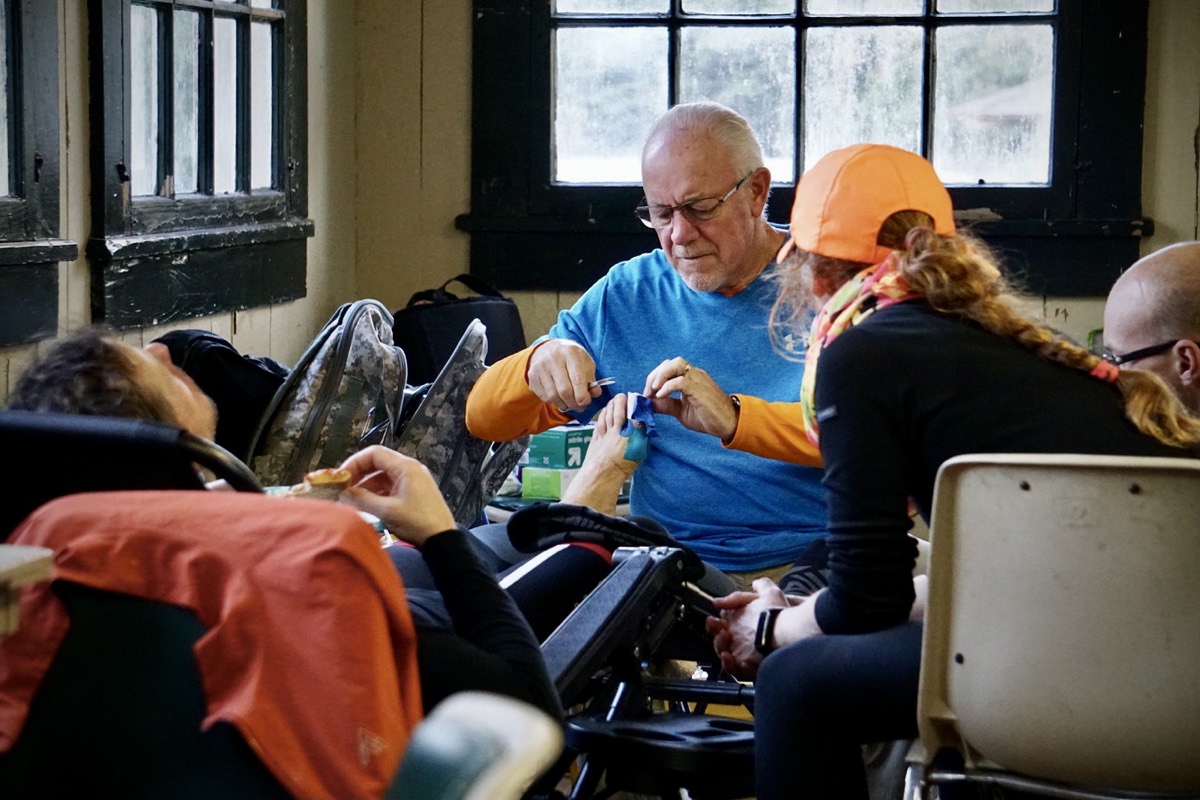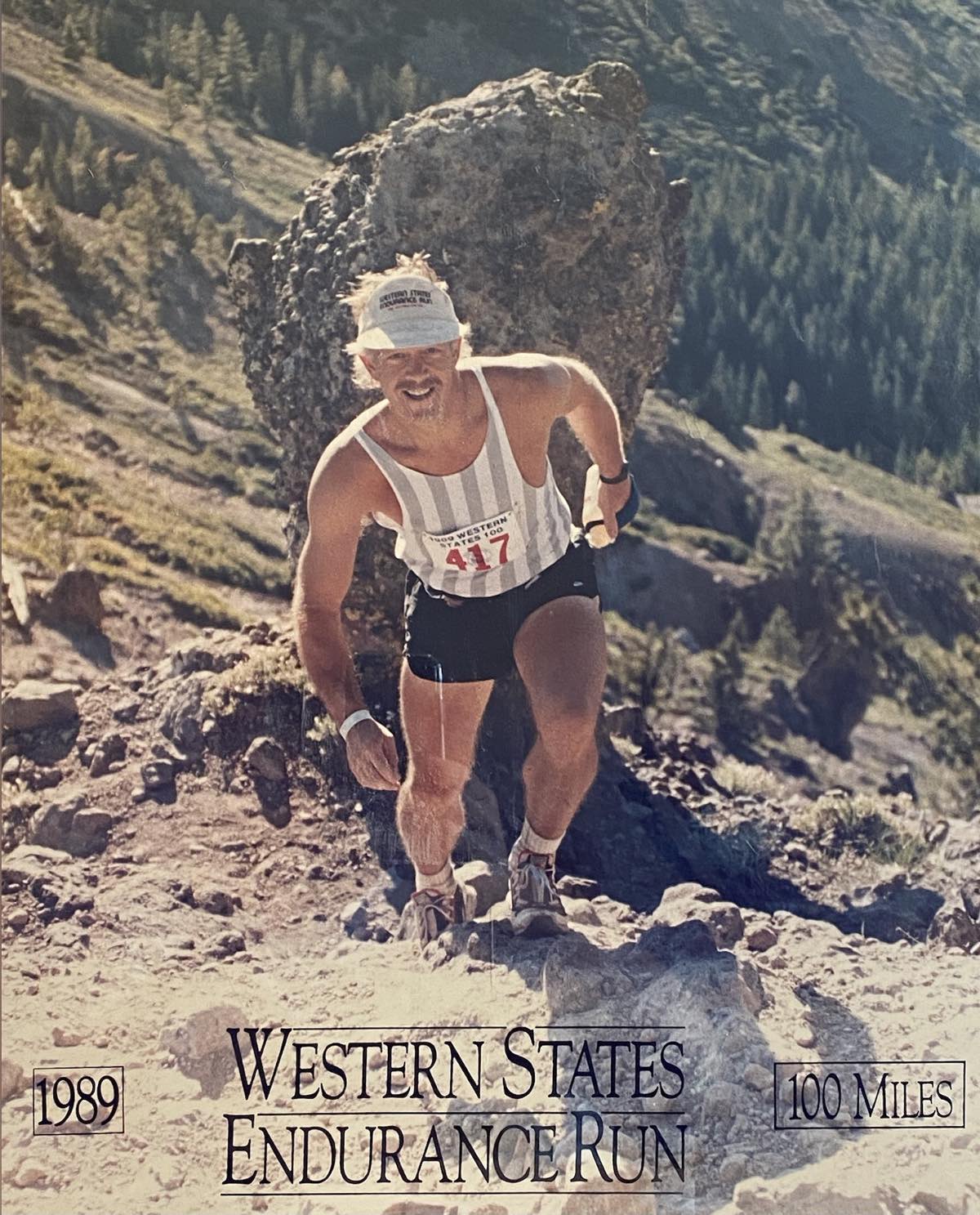Blisters, hot spots, macerated skin, bruised toenails, and more: If you’ve run long enough, you’ve likely encountered some sort of foot issue. While we all know that good foot health is pivotal to our long-distance running goals, we don’t enter into this sport with all the knowledge needed to keep our feet happy. We have to learn it somewhere.
Enter ultrarunner and certified paramedic John Vonhof, who has specialized in foot care and treatment for runners and endurance athletes for nearly three decades, and his iconic handbook, Fixing Your Feet, which was revamped in its seventh edition in November 2021.

John Vonhof is the author of the iconic running health book “Fixing Your Feet.” All photos courtesy of John Vonhof.
Beyond the page, Vonhof’s medical expertise has allowed him to volunteer at endurance events around the world, where he’s patched the injured feet of participants. What’s more, 74-year-old Vonhof is still out there at events with his pop-up tent adjacent to the medical aid, helping to mend athletes’ foot ailments and get them to the finish line.
“I love helping people. It’s a big part of who I am. For 51 years, I’ve been donating platelets — when your blood is taken, platelets are removed, and they give you the red blood cells back — which go to cancer patients. I do it because people need it and I can help, so why not?” said Vonhof, who was born and raised in the San Francisco East Bay.
He briefly ran cross-country as a high-school freshman, which he said he “bombed.” Then after his father passed away, he worked at various stores after school to help support his family, unable to participate in school sports. Vonhof picked back up with running in the late 1970s, after he’d been married for a handful of years, was 36 years old, and still lived in the East Bay.
By 1984, he discovered trail running and ultrarunning. To date, he’s finished more than 20 ultra-distance events including 50ks, 50 milers, 100 milers, 12-hour runs, 24-hour runs, and 72-hour runs, including the Santa Rosa 24-Hour and 12-Hour Track Runs.
“I quickly determined that I had no speed but I had the endurance and mental capacity to run long. I went from the 10k distance to marathons and worked my way up to the 24-hour runs on a track. I did a dozen of those, which I enjoyed because there’s so much a mental game as you’re going around and around this track,” he said.
In the early 1980s, Vonhof paced at the Western States 100, which completely hooked him. He returned as a racer the following year and ran the Western States 100 four times, including one DNF on the final year.
Ever since, he’s volunteered every year at the event in various capacities, like running sweep from the start to Michigan Bluff and working the aid stations at Red Star Ridge, Last Chance, or Michigan Bluff.
Now, after 31 years, Vonhof and his wife moved from California to Tennessee, and he will transition his volunteer time to closer-by races in the U.S. South and East regions.
“I worked all those years at the Western States 100, and writing Fixing Your Feet has opened so many doors. I’ve been to other countries to work at races. It’s all been good. You see the same people at some of the same events, and you might patch their feet one year,” he said.
Beyond specializing in foot care for athletes, Vonhof has had a mixed career path. After graduating from high school in 1965, he soon worked for a telephone company for nearly 26 years. At age 47, he went back to school and earned a degree in childhood education.
Then, he took emergency medical technician and paramedic courses to become a certified paramedic, orthopedic technician, and emergency-room technician. Over the years, he worked with emergency-room teams in three different hospitals, one of which was a trauma center.
“I enjoyed those jobs, because no two days were the same,” he said, and after six years, he joined the Alameda County Emergency Medical Services, where he took on an administrative role as the prehospital care coordinator for a decade, retiring in 2013, at age 65.
Vonhof has two daughters and a son, who are all in their forties and fifties now, and they influenced his path as an author. When Vonhof was racing the 2002 Gibson Ranch Ultra Classic 72-Hour Race, he got a big blister between his large and second toe.
“Someone I knew from doing track runs showed me how to fix my feet and patch the blister with duct tape and that piqued my interest [in foot health]. I was starting paramedic school. My son, who had helped me before at the 24-hour track races, said, ‘I’ve seen you take care of your feet: You know what you’re doing, and you should write a book about it.’”
Vonhof says he took his son’s advice to heart, “I’d written a book previously on a different secular subject. I am good at researching, interviewing, and compiling information into a readable document.” He self-published the first edition of Fixing Your Feet in 1997.
After the second edition in 2000, Wilderness Press published the third edition three years later. Then every five years, the fifth, sixth, and seventh editions were launched. In 2009, Vonhof even became the lead author of a chapter on foot injuries in the book Expedition and Wilderness Medicine.
The current edition of Fixing Your Feet is nearly 70 pages longer than the prior iteration, which is a stout extension.
“I edit chapter by chapter to remove stuff that is outdated or products that are no longer relevant and add in new stuff and validate every product and every website,” he explained.
The book’s updates include additions and changes for the R.I.C.E. method for injuries, the rise of maximalist running shoes, medical studies related to feet, new foot insoles, improved fibers for running socks, and new blister prevention lubricants, to name a few.
Furthermore, Vonhof added, “I’m proud that I had the opportunity to work with and be supported at our aid station at the Western States 100 for 10 years by Tonya Olson, a physical therapist, and she is a contributor in the seventh edition. In addition to reviewing content, she added ‘Tonya’s Tips,’ which includes 47 tips across the chapters that are relative to ice, heat, fitting shoes, sprains, and any number of things — it’s quite a bit more information. Her expertise is valuable.”
Based in St. Petersburg, Florida, Olson owns and runs Centaur Physical Therapy, a physical therapy practice, and is an assistant professor in the physical therapy program at South College in Knoxville, Tennessee.
Assisting athletes as a medical volunteer at endurance events all around the globe, Vonhof has taken his foot expertise to races in the Atacama Desert in Chile and northern British Columbia, Canada. He’s worked on feet in Costa Rica, Brazil, and in the Amazon rainforest — where he slept in a hammock and ate cold food.
He’s helped at events speckled across the United States. Among those, Vonhof volunteered at the 2003 Primal Quest, a multiday adventure race, when it was held in Telluride, Colorado. He set up at the Ironman 70.3 New Orleans, and for 20 years, he helped at Badwater 135.
“I’ve helped 1,000 people or more get as far as they could. I can count on one hand the people I’ve told to stop because their feet were trashed, and it was too early in the race. Their feet were not taken care of due to ill-fitting shoes, not filing down calluses, or not having trimmed toenails.
“The work is satisfying and challenging, particularly when you see the same people year after year, and say, ‘You should know by now how to tape your feet, because I’ve taped them for you for the past three years’,” said Vonhof.
As far as narrowing down tips for runners for their feet? There’s never just one tip, explained Vonhof. However, he noted, “A lot of it boils down to good-fitting shoes. You have got to have shoes that fit your feet — they shouldn’t be shoes that you bought because you like the name, style, or color. If there are spots that rub you wrong, find a different shoe.
“There’s not one perfect shoe for every person or one perfect shoe, period. What feels best on your feet? What has room in the height, length, and width of the toebox? What holds your heel in place? What’s not too bulky on your feet?
“So many shoes have mesh in the top part that’s good for making the shoe lighter and comfortable in the heat, and it also can let in the sand, grit, and dirt, which gets into socks and cakes on your feet and causes hot spots. Find a pair that fits well and try them and if they don’t work, take them back.”
He added that runners also need to wear good running socks — nothing made from cotton — and should consider wearing running gaiters to keep dirt out of their shoes. Consider how much weight is being carried in a pack or fanny pack, and how it affects the feet, and let the feet heal between races. Runners also need to take care of their foot skin and nails.
Vonhof explained, “I don’t like calluses, because if you get a blister under a callus, finding that little, tiny pocket of fluid under the callus of skin can be painful to poke a needle or scapula in there. You’d also be amazed the people that show up with toenails that aren’t trimmed or are way too long or thickened toenails from fungus, and that hurts their race because their toenails get pushed by the toebox of their shoe. Trim your toenails down.”
As for Vonhof’s personal goals, he retired from ultrarunning after the 2005 Tahoe Rim Trail 50k, due to a diagnosis of prostate cancer.
“I went through radiation and the medicine hit me wrong, and I couldn’t run for two years. I didn’t have the energy. I tried to get back into running, but it’s hard when you’re much older and now I have hip issues and muscle imbalances that won’t let me. I haven’t run in ages, and I dream about it. I mainly cycle now, and I’ve done multiple 24-hour bike rides as fundraisers,” he shared.
In June 2022, he’ll be volunteering to work on runners’ feet in Milwaukee, Wisconsin, at Six Days in the Dome. The event is in the “Pettit National Ice Center, which is an oval track around two full-size skating rinks and a speed-skating rink, and they keep it at 55 degrees Fahrenheit. When I was there several years ago, I was on the track for 15 hours a day for eight days straight for the 24-hour, 48-hour, and 6-day races. I had my own area on the side, and I worked on feet,” recounted Vonhof.
For more than 30 years, helping people take care of their feet has brought incredible joy to Vonhof’s work and spirit.
He said, “Seeing bad feet: that’s what I do, and what I’m known for. As odd as it sounds, someone must do it. There are always things to teach people, and I enjoy that. I’ve saved people’s races, and I love them, because it was someone that was going to quit, and they wanted to, and a guy at an aid station said, ‘You gotta talk to John.’ And I patched their feet and sent them out and they finished. Those are fabulous memories.”
Get Your Copy of "Fixing Your Feet"Call for Comments
- Share your stories of John Vonhof patching up your feet in the comments section!
- Leave a comment to share how the book Fixing Your Feet has helped you and your extremities on your trail running and ultrarunning journey.



